Most buyers think that gemstones are evaluated like diamonds. Diamonds are graded based on four physical factors, what we know as the 4 Cs. They are:
• Color
• Clarity
• Cut
• Carat weight
While these 4 Cs are applicable to most gemstones that are opaque and lustrous, there are many more that are opaque like the pearl gemstone, chalcedony gemstones, lapis lazuli, Jadeite gemstone, Carnelian and so on. So, how to pick such gemstones and evaluate their value?
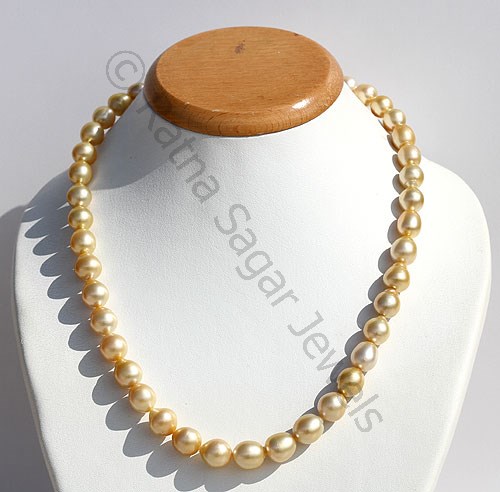
This article is about evaluating the gemstones based on not just the 4 Cs but also moving beyond these usual parameters.
Here are 5 ways a gemstone buyer can establish the exact worth of any gemstone—clear or opaque.
The Source of Gemstone:
There are hundreds of gemstone mines from where world-class grades are extracted. They are then sent to laboratories for cutting, refining and color enhancement procedures. The quality of the gemstone is then established based on the clarity and the physical attributes comparable with the benchmark items.
So, verify the source of the gemstone to evaluate its market value.
Flaws and cracks:
If the gemstone is flawed by any chance, the prices will vary. However, a flawed diamond will still be pegged at a higher order in terms of price as compared to a pure ruby or for that matter, emerald. However, there are many methods by which these flaws can be systematically wiped out or hidden. Thus, the prices of these gemstones with cracked surface still have significantly higher value in the market.
The reason is the amount of effort and resources put to make them look genuine.
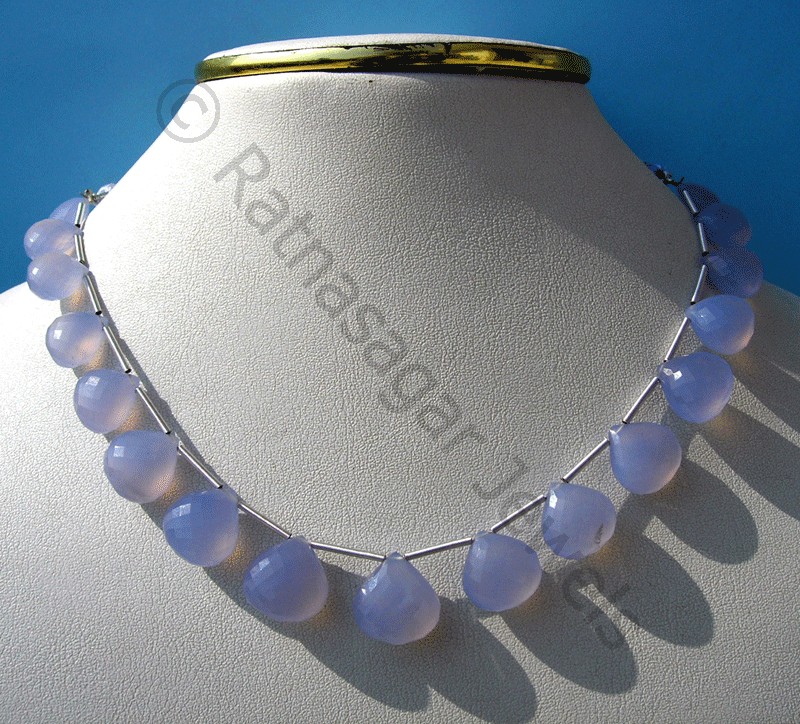
Gemstone reengineering:
This is another factor that can help the buyer estimate the price of the gemstone. Reengineering is done to make the gemstone achieve the comparable ratings of the 4Cs. However, they are more about turning the primary natural gemstone into the saleable item of collection by using different methods like irradiation and laser cutting.
Gemstone re-engineering can transform the physical attributes of the stone drastically.
Hardness and brittleness:
Not all gemstones showcase the same degree of hardness as diamond. In fact, most of the commercially available gemstones have a hardness ranging between 5 and 7.5 on the Mohs scale. Hence, choosing a gemstone with good hardness is very important especially if it is intended to be worn as an accessory for a very long time. Not only will a hard gemstone resist the impact of scratches and cracks, it will also be less brittle.
Evenness of the Color Tone:
Different gemstones exhibit the wide range of colors. Some appear to be distinct while others are part of the various optical phenomena demonstrated under the light. The color shown in the showroom should be the same as shown in the catalogue.
Gemstones of the same family may have two varieties—‘light’ and ‘very dark’ colors. The price usually varies depending on the versatility of the color. Look for hints revealing dyed parts and glass works inside the gemstone.
Save
ad5f69f4-a1a3-45e9-a77b-9deaf217cd74|0|.0|27604f05-86ad-47ef-9e05-950bb762570c
Tags
: Pearl Gemstone Beads . Chalcedony Gemstone Beads . Wholesale Chalcedony Beads . Jadeite gemstones
In the big world of gemstones, no two stones are alike or comparable. Each gemstone comes with its own set of stories and use. However, there are some gemstones with uncanny resemblance when it comes to their structure, appearance and healing properties. The similarity is so obvious that the gemstones are called substitutes.
The same is true for Peridot gemstone, a widely accepted substitute for Emeralds. In fact, Peridot is often referred to as the “Evening Emerald”. It gained massive popularity following the celebrity status that Egyptian queen Cleopatra bestowed on it.
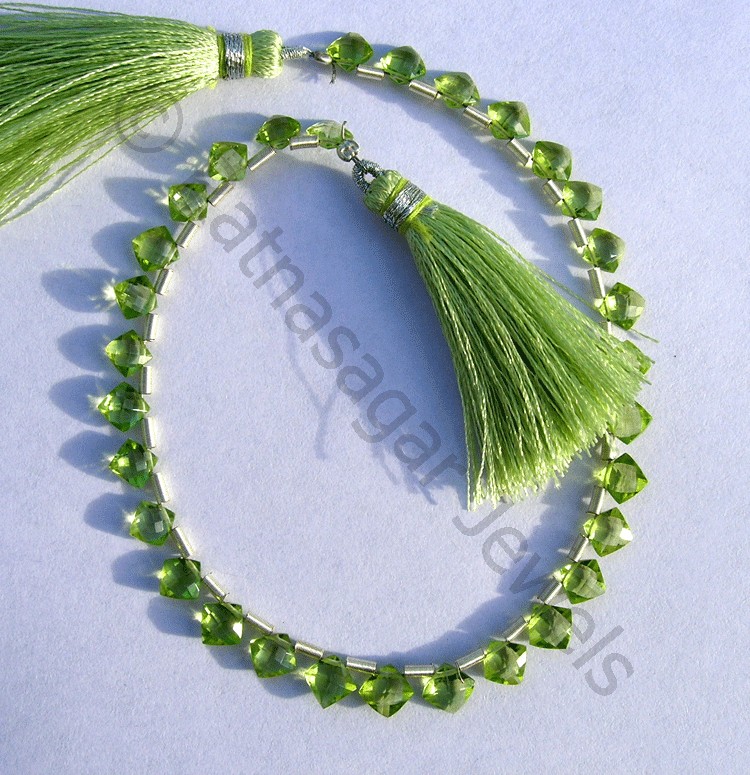
For very long time, peridot was sold as emerald till the gemologists established a clear distinction between the two gemstones.
Let us take a closer look at peridot before identifying it as a substitute for emerald gemstones.
The background story: An Overview on Peridot:
Peridot is basically a silicate gemstone belonging to the family of olivine. It is distinct from the rest of the olivine members by virtue of high concentration of magnesium ions in its structure. The following properties are associated with the period.
- Orthorhombic crystal structure
- Olive-green color, very similar to emerald
- Glassy, lustrous appearance with refractive index of 1.66
- Poor cleavage with Mohs hardness of 7
Peridot is often confused as a part of the emerald family due to its obvious green tinge and refractive index. In fact, even churches of the ancient order bestowed peridot with highest attributes.
How is Peridot different from emeralds?
Emerald is a beryl gemstone with the high concentration of chromium and vanadium ions. The green color is attributed to these ions. Compared to the peridot, emeralds showcase a totally different crystal structure. While peridot has an orthorhombic structure, emerald has hexagonal lattice arrangement.
Secondly, emeralds are harder than peridot. Peridot can be easily scratched by emerald which proves this fact. On Mohs scale, emerald has the hardness between 7.5 and 8. Both emeralds and peridots have a lustrous appearance but emerald has a lower refractive index.
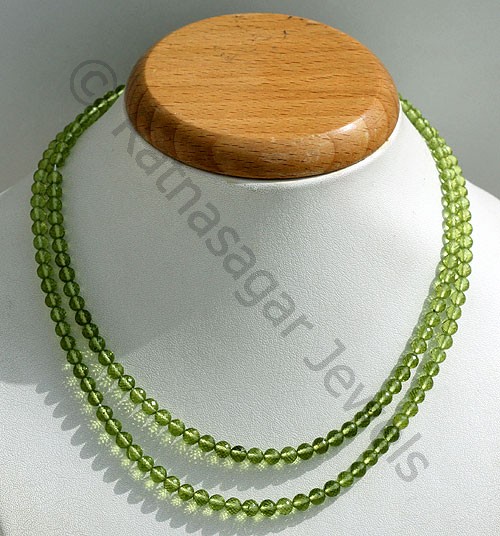
In terms of clarity, color and saturation, emeralds offer a wide range of variety ranging from yellow-green to bluish green and even white. While green is the primary hue of the emeralds, yellow and blue are also part of the collection. On the other hand, peridots are mostly available in yellow-green and dark green-brown shades. Blue-green peridots are very rare but still attributed as existing.
Is peridot a good substitute for emerald?
No, peridot and emerald are different gemstones. While emerald is the birthstone for the month of May, peridot is the birthstone for August. Peridot is commonly sold in the market with the names of olivine and chrysolite. While the sources of emeralds are mostly concentrated in the Asian sub-continent, peridot mines are more wide-spread geographically. Mysteriously, some of the peridot gems are even found to have an extra-terrestrial origin, which is not at all true for the emeralds.
Therefore, mixing up peridot as a substitute for the emeralds may not be a great thing to do. However, look-wise, both are equally dazzling and valuable with high commercial returns.
Save
Save
c3d3c8cd-0a6a-42eb-a834-c5f72449f601|2|5.0|27604f05-86ad-47ef-9e05-950bb762570c
Tags
: Peridot Gemstone . Peridot Faceted Beads . Peridot Gemstone Supplier . AAA Peridot Beads . Peridot Beads
Rubies, like all other gemstones, are evaluated on the basis of their color, clarity, carat and cut. Most buyers find it hard to distinguish between a natural ruby and an artificial one. Due to heavy market demands, the gemstone dealers often supply heat-treated rubies to the buyers. The heat treated rubies are brighter and are found to have less natural flaws. However, the healing properties that a ruby is known for are often missing in the artificial varieties.
Thus it is very important to understand what natural rubies look like, and learn how to distinguish them from the synthetic or heat-treated ones.
1. Hardness test:
Natural rubies are virtually indestructible. With a hardness of 9.0 on Mohs scale, they are closest to diamonds in the gemstone family. They are hardly scratched and remain physically crack-proof for years. If the ruby is scratched by other gemstones, it is definite that the ruby has been artificially polished or irradiated to hide away blemishes.
2. Asterism:
The rubies show a unique optical phenomenon not visible in other gemstones. Asterism, also called as the “Star effect”, is prominent in rubies cut in cabochons. Considering the fact that the natural rubies are the most stable form of aluminum silicates in the gemstone family, the star effect is rather very prominent. Asterism is mostly seen when a constant streak of light is passed through the gemstone, and it glows like a star. Asterism occurs due to the presence of natural impurities in the rubies. In Blue sapphires and pink rubies, this phenomenon is largely attributed to the Titanium oxide present in the crystal in the form of needles and rutile. Thus, a pure natural ruby is very hard to find, especially if the buyer is looking for a gemstone with flawless clarity.
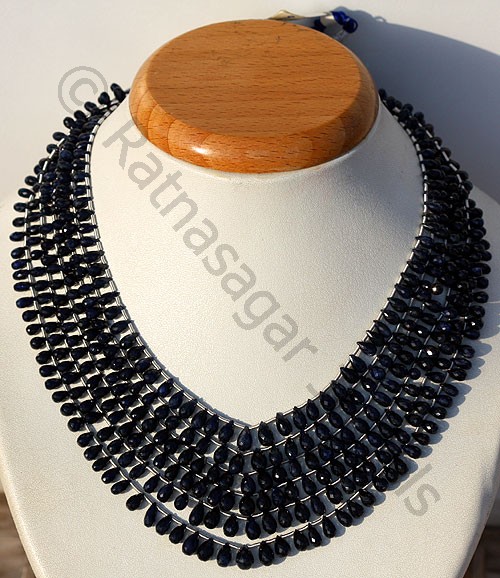
Synthetic ones reveal only 5% of the star effect that is observed in a natural set.
3. A size of the rubies:
Rubies are mostly available in standard sizes measuring 5mm x 3mm, 6mm x 4mm etc. However, this is only exclusive to rubies cut in oval shape. Calibrated cuts result in sizeable weight loss, which is often considered as a loss for the dealer. Thus, rubies are left uncut or at most given a round brilliant cut.
The size of the rubies decides the color maximization, brilliance, and clarity of the gemstone. Inclusions are often removed by grinding or faceting along the plane that contains the inclusion.
4. Color test:
The finest rubies are neither pink nor red. They are more like scarlet shade, resembling the eye of the pigeon to be exact. However, rubies in other colors like red, orange, brown, burnt brown, grey, champagne, golden and tangerine are also found, and highly revered.
Depending on the hue, saturation, and tone of the color, the value of rubies is established.
5. Misleading terms and genuine certificate:
Buyers are duped by sellers into buying rubies sold with dubious names like balas ruby and rubellite. Some glass crystals, spinels, and quartz are also marketed wrongly as rubies. The heat treatment test is best to identify the pure ruby. However, gem laboratories offer certificate on rubies to benefit the buyers. Always check it.
Save
ffddb3e0-9d22-4018-8614-ce38939c8c21|0|.0|27604f05-86ad-47ef-9e05-950bb762570c
Tags
: Blue Sapphire Gemstone Beads . Blue Sapphire Beads . Ruby Gemstones . Ruby Beads
Since ages, topaz has been referred to as a mystic stone owing to its connection with witch craft, sorcery and medicine. In ancient times, it was believed that topaz could cure lunacy and intoxication. A protection stone of sorts, the value of topaz has dropped significantly in recent years due to large scale focus on colored transparent gemstones like sapphires, rubies and diamonds. However, topaz gemstones still hold a commanding position in the market. Here are 5 factors that buyers must consider before making a deal on topaz gemstones.
1. The color:
Like diamond, pure diamond is a transparent gemstone with a slight blue or pink tinge. The tint appears due to presence of many impurities in the gemstone. A typical topaz exudes vibrant colors like tangerine, yellow, citrine and reddish-orange.
Some topaz gemstones are also available in dark brown, green, champagne and reddish blue shades. Lighter the color of the topaz, older the gemstone’s origin is. For instance, the oldest topaz gemstone is a pale green rock that is at least 200 million years old. Stones older than that age are hard to extract owing to drastic change in the earth’s crust that has occurred since that period.
2. Artificial colors and irradiation:
Colored topaz gemstones are very hard to find. In order to meet the demand from the market, natural gemstones are exposed to various heat treatments and artificial color enhancement process. One of them is gemstone irradiation.
According to the latest reports, the topaz is the most commonly irradiated gemstone in the market. Close to 6000 kilograms of topaz gemstones are irradiated each year.
The irradiation process of topaz is done by bombarding the crystal structure of the gemstone by neutrons in a nuclear furnace, under controlled conditions. The process produces vibrant play of color, mostly close to the blue spectrum.
Topaz gemstones that are irradiated artificially are observed to have smooth color stability and uniform clarity.
3. Pleochroism:
Topaz gemstones exhibit a very special optical phenomenon called pleochroism. The best way to identify a pure topaz is to look for this particular optical phenomenon under UV radiation.
When held against a constant source of light, the topaz gemstone tends to change its color when rotated along different planes, Blue topaz gemstone demonstrates the highest level of pleochroism, shifting its color between pale pink and light blue. At certain angles, the gemstone even tends to lose its color and appears as glass/silica structure.
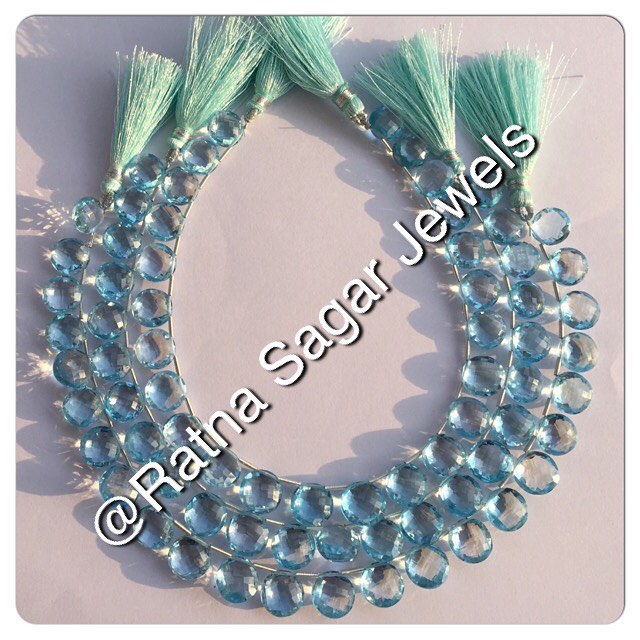
4. Best cuts:
Topaz gemstone ranks very high on the Mohs scale. It has a hardness factor of 8.0 which means that it can’t be easily scratched or cut. It is cut only by diamond cutters and abrasive pads. The most preferred topaz gemstone cuts that have maximum resale value are:
- Ovals
- Marquis
- Pear
- Heat briolette
- Emerald Cuts
- Step-cut/Faceted cube
For anniversary and engagement collections, the topaz gemstones with fancy cut are also very popular. The ideal size is usually 10x8 mm which is around 3 carats. Smaller gemstones are usually available in Brilliants and Princess Cut designs.
Save
501ebdf8-02a0-41a3-b987-0656f091d879|0|.0|27604f05-86ad-47ef-9e05-950bb762570c
Tags
: Blue Topaz Gemstone Beads . Loose Blue Topaz Beads . Blue Topaz Gemstone Beads Manufacturer
Every gemstone is sold on the basis of carat. The carat is a unit of weight like gram, kilogram, ton etc. However, due to the small size and different factors involved in the evaluation of the gemstones, they are sold on per-carat basis. It is wrongfully referred to as a unit of size. Two gemstones with same size can have different carat numbers, and vice versa. It should not be confused with the word Karat used to measure the fineness of gold.
Let us define how gemstones are measured and sold for their value on per-carat basis.
What is carat?
Carat (ct.) is derived from the Latin word carato or carob. Gemstones in ancient times were cut in a way that they resembled the seeds of carob. Even during the classical times, there was a clear distinction between the definition of carat and karat. Carat values were different for different countries as there was no international standard of measurements.
The first instance of using carat as a unit of measurement is recorded in 1570s. The diamonds, for obvious reason was the first gemstone to be calibrated on carat basis.
In 1880, the value of carat was approximately 3.17 grains. In European countries, two carat values were established to measure faceted hearts and faceted squares. They were:
- Pound carat
- Ounce carat
In UK, the popular carat value was called the Refiner’s carat. In terms of milligrams, the value of carat shuffled between 180 mg and 220 mg across the world.
Why was carat standardized?
There are two reasons that led to standardization of the carat value.
1. The growth of commercial gemstone industry:
Gemstones till World War II were largely mined from the European colonies in India, Malaysia, Thailand, Burma, China, Africa and South America. The traders had difficulty in buying different sized gemstones from traditional sellers. In order to establish uniformity of business, the carat value was officially standardized.
2. Creating new cut and facets:
As the new cuts and fancy faceting techniques arrived in the industry, it became necessary to establish a standard value for carat. It ensured that the wastage of gemstone was minimized to a bare minimum. In case, the gem cutter erred in cutting the gemstone, he/she could be fined accordingly on per-carat wastage.
The carat standardization has reduced conflicts and confusions between traders of the gemstones across the world.
What are the different forms of jewelry that use carat as unit of measurement?
Gemstones are used in various jewelry items. The use of carat is common in trading of diamonds, emeralds, garnet, rubies, sapphires, topaz and other transparent gemstones. The various forms of jewelry are:
- Anklets
- Earrings
- Bracelets
- Belly chain
- Navel ring
- Brooch
- Collar pink
- Cufflinks
- Lapel pin
- Pendant
- Tie clip
- Toe ring
- Watches
- Belt buckle
- Pens and glasses
No matter where the gemstone is used, the carat value will remain same.
51119921-279f-4629-a95d-92fda2c7b763|0|.0|27604f05-86ad-47ef-9e05-950bb762570c
Tags
: Emeralds gemstones . Garnet Beads . Ruby gemstone beads . Topaz gemstones
Finding the perfect engagement ring is an arduous task. There are more than 50 different types of gemstone cuts and facet designs that can be picked during the engagement ring shopping. Top faceting like Briolette, faceted heart, faceted cube, step-cut, rose cut and Asscher cut are some of the best aspects that can be explored.
Here are 5 engagement ring cuts that will never go out of any season.
1. Single Cut:
Often regarded as the oldest gemstone cutting idea, Single Cut is made of diamonds, topaz, aquamarine, emeralds, rubies and garnet that are set on gold and platinum engagement ring bands. The Single Cut is characterized by a rather large table and a flat or pointed cutlet, with a total of 18 facets.
Single Cut is chosen for medium-sized gemstones that weigh less than 3 carat.
2. Modern Round Brilliants:
Modern Round Brilliants have been the favorite Engagement ring designs for over a century now. Done to exaggerate the color shade and brilliance of the gemstone, Modern Round Brilliants are now considered as the standard cuts all over the world.
The Modern Brilliants have an alluring round bottom with a total of 58 facets on the stone. Some diamonds and emerald gemstones also have oval cuts.
3. Rose cut:
The first Rose Cut Engagement ring appeared in the 1500s, and since then it has remained a steady choice for the royals and aristocrats. A rose cut engagement ring gemstone resembles the floret pattern of the rose flower with narrow spirals growing upwards from a rather flat bottom.
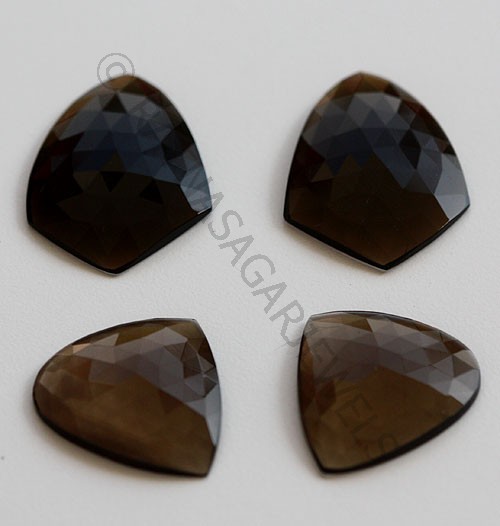
Rose cut settings are mounted on open solitaire way with large surface area. Due to its larger surface area, the brilliance is rather subdued. Round brilliants gemstone are derived from the rose cut settings, ensuring brighter and more brilliant appeal.
4. Asscher Cut:
The biggest gift of the 20th century to the gemstone cutting industry is the Asscher Cut. Produced by Asscher Brothers of the Netherlands, the cut is the symbolic representation of the rise of European gemstone cutting industry in the 1900s. Asscher Cut gained prominence in diamond cutting industry after The Cullinan was cut. Between 1996 and 2012, Asscher Cuts have been embraced with greater respect owing to changes in the designs.
The modern Asscher cuts are made on smaller gemstones with square Faceted cubes and emerald-cut designs. The larger step-cuts are often accompanied by a rather larger crown and narrow table.
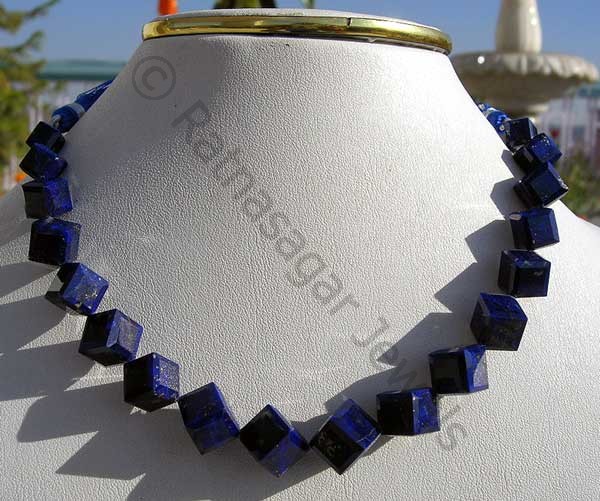
Loved for its perfect symmetry, the Asscher cut gemstones have a Length to Width (L/W ratio of 1:1. Modern Asscher Cut engagement rings also feature a skewed L/W ration of 1.05 and 1.1 too. Owing to the larger, open-ended facets, the Asscher cut gemstone exude a clear and more dazzling brilliance.
5. Heart:
A diversification of the Brilliants, Heart cut is a lovable addition to the collection of Engagement rings gemstones. In these gemstones, the symmetry is the most important aspect as the two lobes have to look identical. It is usually favored if the weight of the gemstone is less than 1 carat.
Save
Save
e8e88b09-fa70-49da-8c99-d057ccc718f9|0|.0|27604f05-86ad-47ef-9e05-950bb762570c
Tags
: Modern Round Brilliants . Rose Cut gemstones . Asscher Cut . Faceted cubes . emerald-cut designs
Since centuries, some gemstones have always been categorized as hot and cold? Are they really that vibrant that wearer can actually experience rise and drop in the temperature of their body? Scientifically, it is proven that some gemstones are indeed special when it comes to exhibiting properties like Piezoelectric Effect, Fluorescence, and Iridescence (also known as gonio-chromism).
While the gemstones are revered for their sparkling beauty and flawless sparkle, here are 5 delectable stones that are actually embraced for their “cooling effect”.
1. Diamond:
One of the costliest rocks on the planet, the diamond was brought into the picture by the ancient Indian gem designers for their cooling effect. The now coolest stone is a fashion winner, and no jewelry collection is complete without these stones. Available in briolette, cushion cut hearts and step-cut designs the diamond is the conventional Birth Stone for the month of April.
In Greek, diamonds are referred to as “invincible”, and the cooling effect only makes it a lucky charm for every individual—housewife, businessmen, traders, sailors, doctors and religious leaders.
2. Ruby:
Numerous studies are underway when it comes to establishing the connection between wearing the faceted cube rubies bracelet and soothing down the nerves. The fiery red color could confuse any person who is not aware of the healing properties of the rubies. As per research, the Chromium ion (Cr3+) exudes an optically-powered cooling effect which could easily lower the temperature by several degrees if purity and aesthetic values are maintained.
3. Sapphire:
Obviously, much like its red counterpart, the rubies; sapphires too have the special cooling effect. The Birthstone for the month of September, Sapphire has always been associated with the moon for its coolness and tranquility. However, the underlying scientific reason for its dermal cooling phenomenon is yet to be established and confirmed clinically.
The effect is likely to be attributed to the presence of iron, chromium, magnesium and copper. Blue sapphires have the higher cooling effect than the pink and yellow shades.
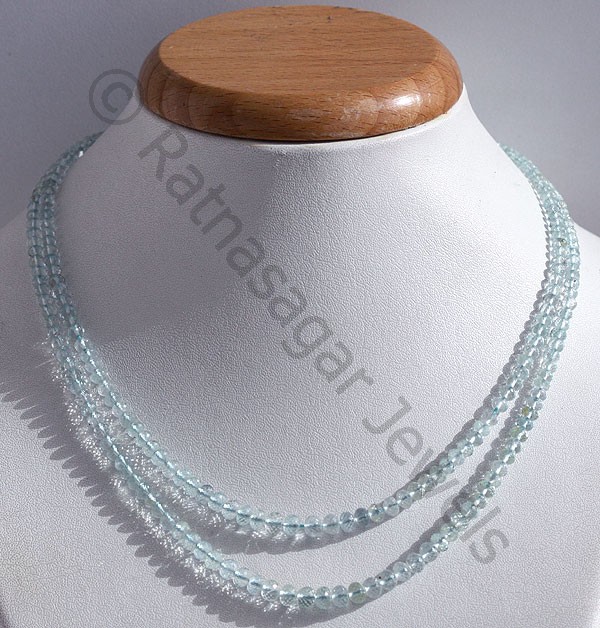
The cooling effect is one of the healing properties of the sapphire that makes it effective in the treatment of ear pain, back pain, lumbago, Parkinson’s disease and depression.
4. Topaz:
Now this something not many gemstone collectors knows about the Topaz. A regular item in Ayurveda, the gemstone was used to treat tongue infections, sexual dysfunctions, improve vision and purify the blood. Used with rubies and pearl extracts, the calx of topaz also effective treats symptoms associated with leprosy, skin disorders and blisters on elbows and palms.
5. Aquamarine:
A gemstone from the beryl family, Aquamarine beads is a beryl that has been used in Ayurveda to treat coughs and throat related issues. The blue color of Aquamarine is attributed to the Fe2+ and Fe3+ ions. The concentration of the ions can produce other colors like green, yellow and even pink. However, only blue beryl in the form of Aquamarine are used in the form of dew-drop briolette, faceted round or nugget shapes.
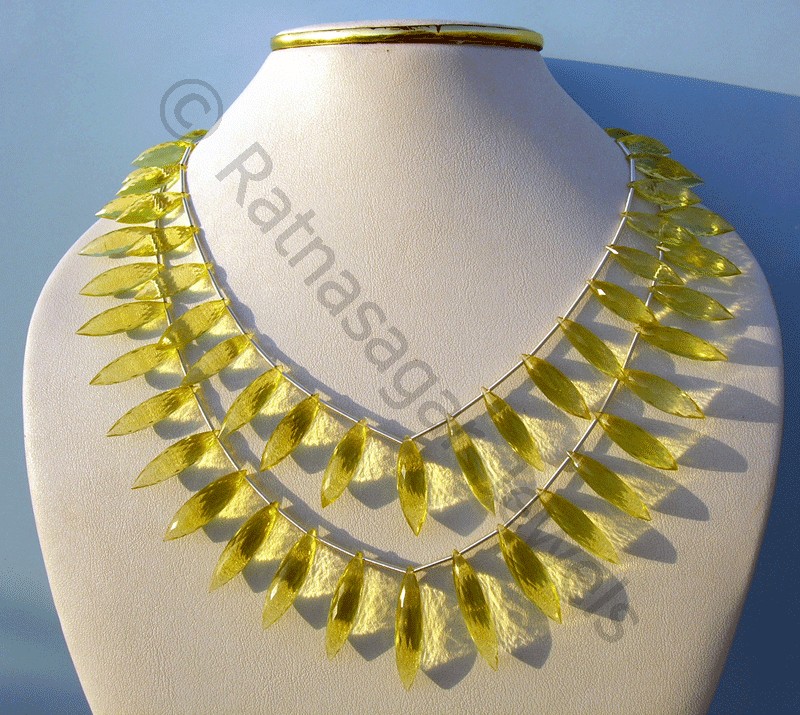
These 5 gemstones can be worn around the neck, wrist, or around the waist. Some individuals even prefer to stud their eyeglasses with these gemstones for extra cooling effect.
Save
Save
b41bd336-6b58-4945-a53b-d47e5d17a2f5|0|.0|27604f05-86ad-47ef-9e05-950bb762570c
Tags
: Aquamarine beads . Blue sapphires Gemstones . Ruby Beads . Diamond Beads
Facing and cutting results in sizeable loss of crystal material. However, without the faceting process, the raw gemstones will hold no commercial value whatsoever. A diamond with exquisite faceting has at least 400% more value than a raw, dark rock. However, more than anything else, it is the choice of cut that earns the gemstone its repute in the collection.
Here are 3 top-end fancy cuts that every buyer must explore.
Modified brilliants:
They modified brilliants are recent entrants in the collection of fancy-cut gemstones. They are direct descendants of the original brilliant-cut gemstone. They differ from their older sibling by virtue of having an extra row of facets. They look like a crushed ice crystal owing to the half-length pavilion that does not touch the girdle.
Cheaper than the original cushion cut brilliant gemstones, the modified gemstones is preferred only when there is a distinct flaw in the crystal at a particular angle. The modified brilliant cut hides the flaw by resembling a floral shape.
Regarded as the most commercially saleable cut in the industry, the modified brilliants can be further classified into Marquis, Hearts, Trillions and Briolette depending on the size of the raw gemstone. They have a length to width ratio ranging between 1.33 and 1.66, making them look heavier and bigger compared to other cuts. Moreover, the Modified Brilliants can be developed further into intricate shapes of stars, floral and butterflies, without affecting the brilliance and fire interplay.
Modified brilliants can have 56, 102 or 144 facets with 8-fold or 10-fold facets.
Step cuts:
Gemstones that resemble a cube or dice are very popular. The most alluring shape is the faceted cube that exhibits a square or a rectangular outline with facets running parallel to the girdle. Also called the Trap cut gemstones, these step cuts are produced by making flat stepped incisions on the stone. They could feature rows or series of steps in a narrow, long plane.
The popular gemstones that are often given a step-cut are topaz, emerald, amethyst, agate, and tourmaline gemstones.
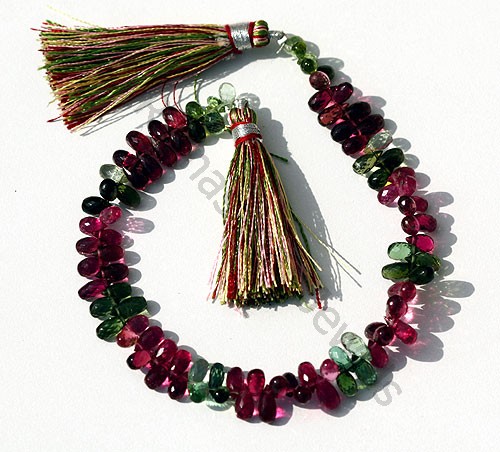
How to identify a genuine step-cut gemstone? In step-cut gemstones, the corners are often truncated into an octagonal contour to avoid sharp edges from cutting skin. Moreover, the truncated outline prevents the gemstones from cracking up. In theory, sharp edges are point of weakness that can lead to cleave or a fracture. The length to width ratio is 1.50.
Step-cut gemstones are often re-cut into smaller brilliants and briolette shapes to bring in more revenue per-carat.
Mixed Cut:
Also called the hybrid cushion cuts, the mixed cut gemstones reveal fascinating features of both Brilliants and the Ste-cut gemstones. The crown resembles a brilliant cut, with a pavilion that is cleaved in step-cut. The first mixed cut gemstone was produced in the middle of the Cold War when Brilliants were temporarily replaced by Fancy cuts in Step-cut and briolette designs.
The popular Mixed Cut is the Barion Cut, invented by a South African trader. With a total of 62 facets, it can be easily identified from the rest of the collection.
Save
994c8891-5c97-489a-ad27-345c224b4014|0|.0|27604f05-86ad-47ef-9e05-950bb762570c
Tags
: Brilliant Cut Gemstone . Topaz Gemstones . Tourmaline gemstone Beads
Anniversaries are special, and they can be made memorable by gifting a lovely, delicate natural gemstone ring and neckpiece collection. The buyers are always on the lookout for new designs and cuts in the gemstone segment. Each year 100,000 gemstones are flooded into the market cut in different ways. However, not all gemstones have the same styling or faceting. Some might have a lower critical angle compared to other; most gemstones might just exhibit a slightly different shade from what it was a raw item.
Here are 4 factors that every buyer must compare between different facets and designs before picking an anniversary ring.
1. Age of the gemstone:
This is a key aspect of buying a natural gemstone anniversary ring. The date of extraction from the quarry, the date of cutting and manufacturing are important factors that can make a sizeable impact on the price of the gemstone. While most gemstones are hardly a year old, high-priced Anniversary ring gemstones could be as old as 50 years or more.
Another reason why buyers must investigate the date of manufacturing of the gemstone is to stay clear of the Black Diamonds and smuggled rubies, garnets, black moonstone, emeralds, black tourmaline and sapphires that have ripped apart the economy of many African countries.
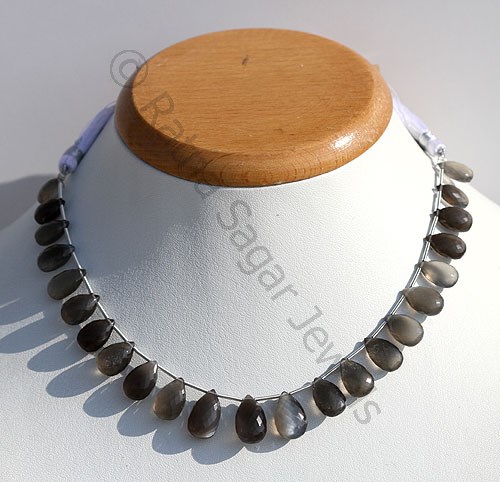
2. The shape of the gemstone:
Anniversary gemstones are cut in 10 commonly accepted shapes. The 10 shapes are:
1. Round
2. Princess
3. Oval
4. Marquis
5. Pear/ Briolette
6. Cushion
7. Asscher
8. Radiant
9. Emerald
10. Heart
More than 75 percent gemstones are shaped in round brilliants. In recent times, Asscher and Princess Cut anniversary gemstones have gained immense popularity, thanks to LASER cutting techniques. For special occasions other than anniversaries like Valentine’s Day and Engagement, Heart shaped gems are also preferred. The radiant cut gemstones are also accepted widely for their unique bow-tie effect. For buyers looking for a mixed cut anniversary ring resembling Princess Cut and Cushion Cut, the Radiant-cut gemstones fit in flawlessly.
3. Symmetry:
Anniversary gemstones have to necessarily exhibit the highest level of symmetry. Symmetry showcases the quality of gem cutting and is calibrated by measuring the table, girdle, and Length/Width ratio. Perfect symmetry in the anniversary gemstones ensure that the light is brilliantly reflected and faults are strategically hidden.
A poorly shaped gemstone invariably has a bad symmetry too. The highest symmetry of the gemstone is established under 10-X magnification with zero defects.
4. The cut:
The way the Anniversary gemstone is cut can have a huge impact on its life, durability, and overall price. The gemstone has to be cut in such a way that the light is reflected from the pavilion at an angle lower than the Critical Angle. This ensures that the light is reflected effectively from the pavilion to the crown creating a scintillating fiery brilliance.
The cut also establishes the price of the Anniversary gemstone. A ruby or a diamond with a heavy girdle indicates that the gemstone will have more weight but would not look big from the top view.
Save
e41e3879-6c11-40b2-bc09-713d3c912580|0|.0|27604f05-86ad-47ef-9e05-950bb762570c
Tags
: Black Moonstone Beads . Black Tourmaline . Sapphire Gemstones . Princess Cut . Radiant-cut gemstones
Big, handsome and subtle… these are some of the ravishing adjectives used by emerald collectors. However, more than the brilliance of the gemstone, it is the way they are cut that makes them so popular. Step-cut or trap cut emeralds gemstone beads are expected to fetch the highest price considering their alluring beauty and per carat weight. Also called Emerald Classics, the step-cut is undoubtedly the first choice for most emerald dealers.
If you are new to gemstone market, here are 5 reasons why Emerald-cut items safest to deal with.
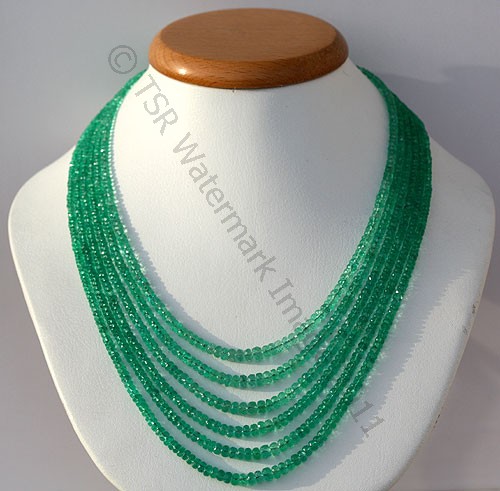
1. The most symmetrical cut ever:
The Emerald Cuts are revered for their pristine beauty and symmetry, hard to match by regular cuts like Brilliants and Cushions. The step-cut is made in such a manner that every facet in the gemstone is capable of reflecting light. The cuts are made parallel to the girdle, which means that the gemstone acquire a distinct, flat and uniform table for highest stability.
The facets could be completely squared off or it could be given a slightly truncated edge to ensure that the points of weaknesses are minimized.
2. Strongest configuration:
The emerald cut gemstones are considered as tough and strong. They don’t chip away easily, especially if they have truncated corners. The stones with hardness less than 7.0 on the Mohs scale are usually given the Step-cut to ensure that the finished item stay intact and never crack or facture along the points of weakness.
Citrine, Diaspore, Tourmaline, topaz, and quartz acquire strength by virtue of the Emerald cut or step-cut done on them.
3. There is no compromise:
Step-cuts or emerald cut gemstones have long been accused of hiding the brilliance that comes out well when the same gemstone is cut in Round Brilliants or in Heart Briolette shapes.
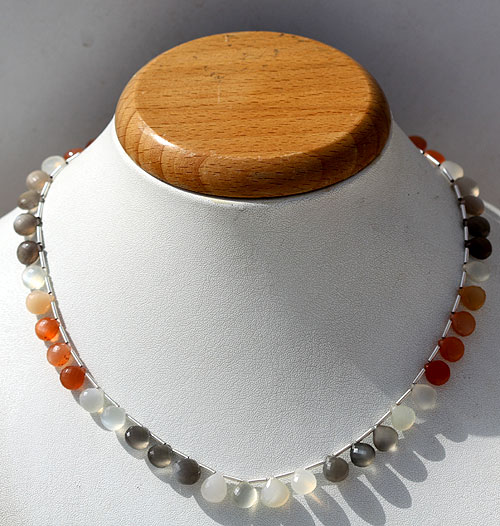
However, this accusation is not entirely true. The step-cut gemstone indeed loss 12-15% of their brilliance over round brilliants; they earn 50% extra strength when compared to the same set of gemstones. In short, emerald and topaz collectors prefer to have a stronger, velvety gemstone than ending up with a weak one.
Hence, there is no compromise as far as cutting a gemstone into steps is concerned.
4. No heat treatments and dyeing involved:
The emerald cut gemstones with step-cuts can be used for engagement rings, necklace, pendants, earrings, nose ring and bracelets. The talismans and rosaries too have emerald cut gemstones made of tourmaline, garnet, rubies and quartz.
The weight of the step-cut gemstone hovers around 2.3 to 4 carats. They have hardly treated artificially or dyed. Heat-treated Emerald cut gemstones can be easily identified from their purer counterparts, and hence they are least subjected to any artificial treatments
5. Opaque versus transparent:
The step-cut can be made on any gemstone with hardness above 5.0. The opaque gemstones like black diamond, spinel, lapis lazuli and onyx can be either given a rough step cut or merely placed in the form of a Faceted Nugget. Without the doubt, the faceting with step-cuts is more popular on translucent gemstones than the opaque ones.
Save
Save
8e528a7f-f81c-4b4b-99bc-a60b0d978a42|0|.0|27604f05-86ad-47ef-9e05-950bb762570c
Tags
: Heart Briolette Shapes . Emeralds Gemstone Beads . Tourmaline Gemstones . black diamond